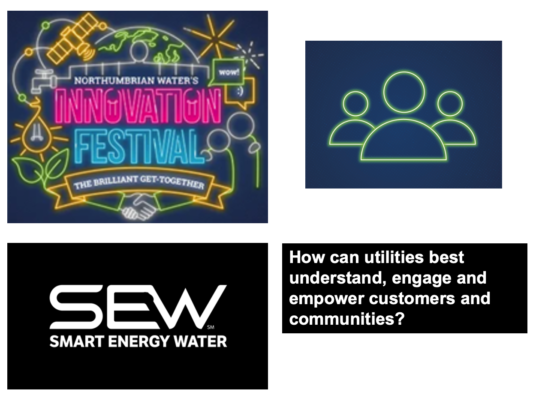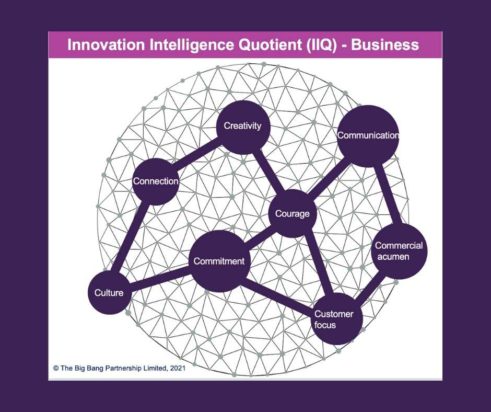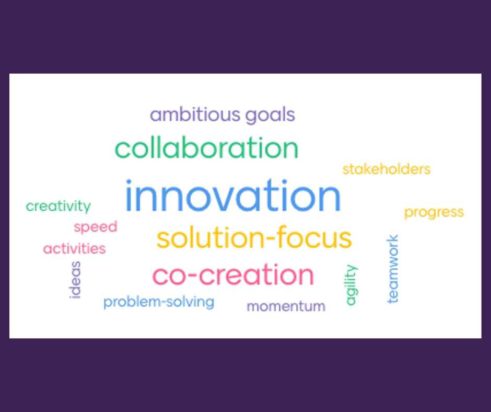Posted in Blog, Design Thinking, Facilitation, Innovation, Innovation, Innovation Culture, Virtual Facilitation by Jo North
How does an innovation sprint work?
What are they and when should you have one?
How do you make an innovation sprint a success?
When might it be useful to do an innovation sprint? And when might it not be?
And if you’re thinking about running an innovation sprint in your organization, how can you make sure that you really get the most out of the investment in everyone’s time?
I’ll answer all these questions, and more, in this article.
Introduction to the innovation sprint
I’m writing this article right in the middle of the Innovation Festival 2021 for Northumbrian Water Group. I’ve facilitated innovation sprints at the event for the last four years. Twice in-person and twice as a virtual innovation sprint.
This year’s innovation sprint is sponsored by Smart Energy Water, alongside Northumbrian Water. We’re exploring how utilities better understand, engage and empower customers and communities in the future.

Innovation sprints dovetail into my organizing framework of successful innovation. When we break it down, innovation is a complex process. We’re envisioning the future, and then working to make that future happen.
Successful innovation requires a blend of creativity, communication, courage to go out and try new things, commitment to get ideas off the ground, connection, and collaboration. Working together, we can do so much more than we can do on our own.
We need to create the right culture and environment for innovation to succeed.
It’s important to be be super customer focused, and also commercial as well.
Innovation sprints combine all of these. They hothouse the thinking and collaboration it and really amp it up to the next level.

What is an innovation sprint?
An innovation sprint is a short, focused event, that gets all the right people in the physical or virtual room to collaborate on a mission.
The sprint mission is a big challenge or opportunity that is significant to you, your team or organization. It’s something that you genuinely want to crack.
Innovation sprints are designed to get the very best collective creativity and wisdom from everyone present in an efficient, dynamic, and creative way, in a short space of time.
What sorts of challenges or opportunities can an innovation sprint help with?
Here are some examples of innovation sprint challenges that we have worked on here at The Big Bang Partnership in just the last few months. We facilitate innovation sprints most weeks!
• New product or service development
• Advanced engineering solutions
• Customer and employee engagement
• Customer and employee experience
• Marketing initiatives – branding, awareness and behavior change campaigns
• Digital technology solutions – new software, app development, website development
• Net zero / decarbonization and climate change – environment strategy, electrification, renewable energy
• And many more!
If the challenge is knotty, important, and complex enough, an innovation sprint can go a long way to helping you to get some traction in cracking it.
What are some of the benefits of an innovation sprint?
In addition to being a focused and fast way or getting results for your organization, an innovation sprint will bring these benefits for your organization:
• Improved collaboration and teamwork
• Creative problem-solving skills and innovation expertise
• Better quality debate

Who should the participants in an innovation sprint be?
You’ll certainly want to invite the subject matter experts.
Also invite people who have a limited knowledge of the technical aspects of your challenge. They will be brilliant wild cards, ask fundamental questions that will get everyone thinking differently, and add value to your innovation sprint dynamic.
Lightning talks, expert interviews and fireside chats
Invite people to give what I call lightning talks, expert interviews or fireside chats at your innovation sprint. You’ll need perspectives on the challenge from key stakeholders, and these are great ways of structuring those into your sprint activities.
Make some of these sessions inspirational or thought-provoking, too. You can invite people who have solved a similar or related challenge elsewhere, for example, to share their stories at your sprint. These don’t have to be people from inside your organization. Even better, in fact, if some of them come from outside it.
Remember that not everyone has to stay for the whole sprint. Some people can pop in, contribute and leave.
Involve customers in your innovation sprint
Bring trusted customers into the sprint if you can at key stages. They will give you some invaluable feedback. Hear from them about the problems and opportunities they would like you solve at the beginning, then test your ideas with them at the end.
Consider running an innovation sprint for and with your clients. It’s a great way of shaping a specification or brief from them for commissions such as app or tech development, growth and engagement strategies.
How many people should you have in an innovation sprint?
There’s no particular rule around how many people should participate in an innovation sprint, in my view.
You need enough people to spark and sustain creative thinking throughout the sprint, mix up the groups and have some positively disruptive conversations.
A minimum number for this is about eight, and I’ve sprinted with anywhere up to 120-130 people.
The important things are for the innovation sprint design to be appropriate for the number of participants, and for the innovation sprint facilitator to have enough hands-on support to manage the number of people present.
These rules apply whether your innovation sprint is physical – i.e., people are in the same physical space – or online.
How long does an innovation sprint take?
An innovation sprint can last for anything between half a day to five days. The duration really depends on the size and complexity of the challenge that you’re working on.
When a sprint runs over days, it used to be that these days were back-to-back. Now I’m finding more and more that organizations are spreading their innovation sprint activities out over two to six weeks, even longer sometimes.
The advantages of innovation sprinting in one hit are that it’s dynamic, pacey, focused and done quickly.
The benefits of spreading the sprint sessions out more are that often more people can attend, as taking a big chunk of time out of the diary for an innovation sprint is a big ask. Work on the sprint mission can happen between sessions, and the participants’ creative subconscious minds have time to build on the ideas, questions and potential solutions that the sprint produces.
What process does an innovation sprint follow?
There are different innovation sprint processes. One of the most common is in the book Sprint by Jake Knapp of Google Ventures. This is a great starting point for beginners but bear in mind that the book shows just one way. It’s not the only or necessarily the best way.
Innovation sprints are also often called ‘design sprints.’ The two terms tend to be used almost interchangeably, from my experience. Design sprints place the emphasis on ‘thinking like a designer’, with the customer or end user rightly at the centre of the whole process. The leading authority on design thinking in my view is Stanford University’s d.school.
Keeping your innovation sprints fresh
Over the years I have developed a massive toolkit of literally hundreds of innovation sprint activities and processes that we share with the facilitators we coach here at The Big Bang Partnership, and with the organizations who commission us.
We create a bespoke combination of innovation sprint activities and processes for every client. Clients can replicate these in-house for themselves and have access to a variety of alternatives to keep their innovation sprints fresh.
Remember that subjecting the same people to the same process repeatedly means that your innovation sprints will lose their freshness and edge. Please don’t stick relentlessly to a single approach!
The Big Bang Partnership’s innovation sprint process
The Big Bang Partnership innovation sprint process follows these principles:
• Bull’s eye session – to fully understand and explore the innovation sprint mission, any data, different stakeholder perspectives and agree on key questions
• Ideation – idea generation, a brilliantly creative stage!
• Idea selection and development – selecting the most promising ideas and building on them
• Campaign, solution, prototype development (depending on what the innovation sprint is for)
• Idea testing
• Action planning

Are innovation sprints new?
The underlying principles of innovation sprints aren’t as new as we might think. There are many similarities with the Osborn-Parnes Creative Problem Solving (CPS) Process from the 1950s. This is a structured method of coming up with creative and innovative ways to find solutions to problems and opportunities.
Creative Problem Solving (CPS) is a step-by-step process designed to spark creative thinking, resulting in the generation of innovative solutions and purposeful change.
Dr. Jo North, PhD Thesis
The Creative Problem Solving Process (CPS)
The originator of the Creative Problem Solving Process, Alex Osborn, was a founding partner of an American advertising agency. He published a seven-stage Creative Problem Solving Process (Osborn, 1952), which comprises ‘Orientation’, ‘Preparation’, ‘Analysis’, ‘Hypothesis’, ‘Incubation’, ‘Synthesis’, and ‘Verification’.
Osborn’s further publications throughout the 1950s and 1960s raised general awareness of the method (and also launched the concept of ‘brainstorming’ into common practice and language for the first time).
Later, in 1967, Osborn refined his process to contain only three stages: ‘fact-finding’; idea finding’; and ‘solution finding’.
Osborn met and began to collaborate with Sidney Parnes, who continued to develop Osborn’s work after he died to create a five-stage process in the late 1960s, with the educational purpose of enabling students to develop their personal creativity.
Through the application of the five-stage process in a range of education progams in the US, the model became known as the Osborn-Parnes Creative Problem Solving Model, the 5 stages being ‘fact-finding’, ‘problem-finding’, ‘idea-finding’, ‘solution-finding’ and ‘acceptance-finding’. This was further developed collaboratively with others through the 1970s and beyond.
Despite many iterations and developments since then, we can still see the absolute core of the innovation sprint process that is in use today.
Convergent and divergent thinking
Innovation sprints are designed to help participants apply the most appropriate thinking mode for the task in hand. The process requires alternating between convergent and divergent thinking throughout the innovation sprint process.
The psychologist J.P. Guilford first coined the terms convergent thinking and divergent thinking in
1956.
Divergent thinking is a thought process or method used to generate creative ideas by exploring
many possible solutions. Divergent thinking most often happens in a spontaneous, free-flowing,
way, so that many ideas are generated. Many possible solutions are produced in a short amount of
time, and quite often people come up with fresh, innovative perspectives and new connections between ideas as a result.
Convergent thinking is a mode used to critique, analyze, select and narrow down the most promising ideas. It’s usually logical, linear and focused. Convergent thinking organizes and structures the high number of ideas that the innovation sprint produces.
Is an innovation sprint right for your organization?
If you’ve got something significant that you want to achieve, that isn’t straightforward, that requires the best of everybody working together, and potentially with external people as well, then yes, a sprint can absolutely help you.
I’m really happy to explore whether an innovation sprint is right for your organization with you.
If it’s something you’ve not done before, and you want to give it a go in your business, we can help you.
How to guarantee a successful innovation sprint
Here are my 10 tips to make sure that your innovation sprint is successful.
1. Have a clear innovation sprint mission
It is important to have a clear mission, to know what you want to achieve. And to be able to express that succinctly.
This is because you’re going to spend a lot of time solving your innovation sprint mission.
If I had an hour to solve a problem I’d spend 55 minutes thinking about the problem and five minutes thinking about solutions.”
Albert Einstein
2. Don’t try to do too much
Ensure that you’re not trying to do too much, that you’re very focused and zoned in on what you want to achieve and that you can communicate your sprint mission. That’s starting point of the sprint, the ‘exam question’ that everybody’s working on, all the way through.
3. Invite the right people
This doesn’t necessarily mean necessarily only the experts. It’s great for them to be present, and it’s also brilliant to add in people who aren’t experts too.
Remember that Uber wasn’t started by people who were already driving taxis! Uber was started by people with software vision and capability who saw opportunity in the taxi market. Mix it up, have a really diverse group, including people from outside your business, and have the experts there as well.
4. You need a great facilitator.
A great facilitator makes innovation sprint facilitation look really, really easy, but it’s a tougher job than it looks. Think about it:
- Over a number of days, or sessions, the facilitator needs to bring people together, often people who haven’t worked together before in that way. They have got to create a sense of psychological safety really quickly and get everybody working as a team from the off.
- The facilitator needs to manage the whole process and the time to ensure that you come out with the solution, the objective that you want to achieve by the end of the sprint session.
- It’s the job of the facilitator to create the right environment. The facilitator designs and manages the whole process and time to achieve the end goal.
- Lots of work that goes in beforehand to make sure that sprint is right. The facilitator needs a plan, and they need to be able to adapt the plan, responding with agility as new ideas and new thinking comes out from the group. Your facilitator will need to move with and keep up with the thinking that emerges. A level of smartness and intelligence to follow the thread and see where all the different dynamics are heading is crucial.
- The sprint facilitator needs to create a great delegate experience as well.
So there’s there’s quite a lot there to be thinking about and doing. And if you overlay things like technology into the mix, which is fairly intuitive, but it’s still another thing to think about, then getting a great facilitator can really make the difference.
5. Every sprint should be customer focused.
Know who your end user is. It doesn’t have to be an outside customer who’s buying something, it might be employees within the organization.
Either way, make sure that you’re holding the customer at the center of everybody’s thinking, so that your sprint solution at the end of it works and is valuable.
6. Cultivate great support and challenge.
It’s important to have healthy debates in a positive, encouraging environment. You need appropriate creative tension at times for ideas to come through. A great facilitator that knows how to do that, and how to get the best out of people.
7. Structure your innovation sprint to create a brilliant energy mix.
Sometimes you’ll need to be thoughtful in the sprint, processing ideas and thinking about topics in a bit more depth. At other times you’ll need high energy and some fun. It’s important to vary between people working alone and working in groups.
The sprint process should definitely not be about putting people through a sausage machine, and outputting a load of sausages at the end. It should be about creating a really bespoke mix of activities and energies to get the right outcomes.
8. You’ll need an appropriate venue and tech that works well for you.
9. Get ready for your next steps.
Before your innovation sprint, plan how you will follow up on the ideas and action plan. Nobody wants to spend all that time having great ideas and getting somewhere, for it all to just be forgotten as soon as everybody leaves the room. An innovation sprint is the start of the journey. Plan for what’s going to happen at the end of that journey and build that into the sprint process.
10. Get your data and information ready
Have the right background information and data available.
In advance, prepare the information that people will need to know in order to work on your innovation sprint mission productively.

Next steps
There’s a lot here to help you decide whether an innovation sprint is right for your organization.
If you haven’t done an innovation sprint before, I do encourage you to give it a go. Whilst it might sound a lot, working with a great facilitator (we’d love you to work with us!) takes so much work for you out of the process, and ensures your success, so please do get in touch.
Either way, I’ve got all sorts of resources that can help you with your innovation sprint. Have a look at these free articles and YouTube videos that I’ve created for you.
My purpose is to help you innovate and help you get to where you want to with you, your team and your organization. I hope you’ve found this article useful, thank you for taking the time to read it.
Happy innovation sprinting!

